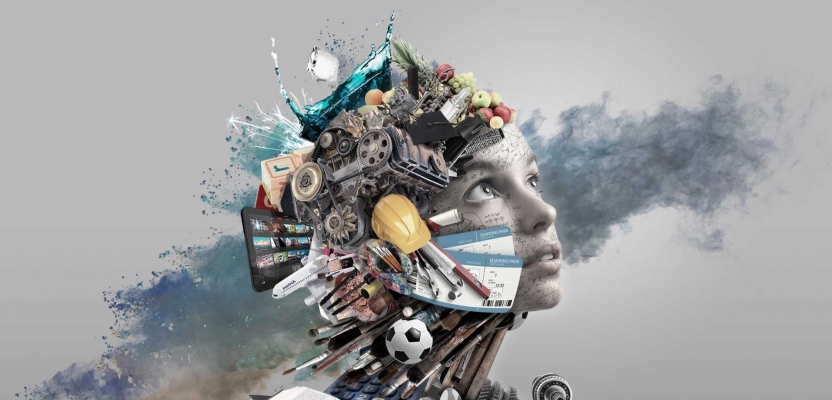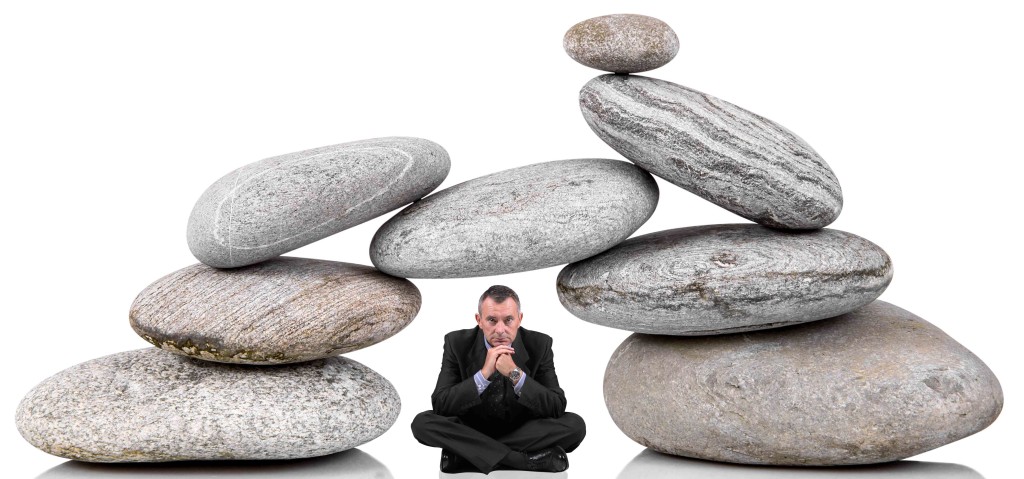Why Certainty is an Inside Job

I live in Sydney, Australia. But this story could be set in any other big city. My city is going through major change. New railway lines are being built connecting up suburbs around the CBD, theoretically making travel around our huge city much easier while taking cars off the road. Houses are being knocked down to construct apartment buildings. Roads are being widened to carry the traffic; roundabouts installed to improve traffic flow, roads limited to one-way traffic or speed bumps and chicanes built to discourage the ‘rabbit runs’. Office buildings are being renovated or replaced. You get the drift. Chaos! When I visit a part of the city I haven’t been to in a while, it’s highly likely it doesn’t look the same. Being visual, I navigate an area by the combined look of the buildings. Now, there’s nothing certain in my city unless it’s that it is constantly changing. It’s like being blindfolded with nothing familiar to navigate by That’s not unlike life. Technology has single-handedly flipped our world. Business models are being disrupted as savvy business people use technology to create more efficient and effective ways to both access and provide services. We humans have a challenge with uncertainty – and that’s the environment we now live in constantly. We want the stimulation of variety, but we also need certainty. These two needs work together in balance. If we have too much certainty, we become bored. On the other hand, too much uncertainty can lead to insecurity and anxious behaviour. This balance is even more precarious when we place greater emphasis on external validation of our identity, our worth, our performance and our behaviours. We can feel like a cork bobbing on a stormy ocean – completely at the effect of what is going on outside ourselves. People with an external locus of control believe external forces like luck determine their outcomes. This is one of the symptoms of the Imposter Syndrome and feeling we’re not good enough. There are a number of pathways to counteract the feeling of being at the effect of what goes on around us – and they help us find personal certainty in an uncertain world: Find your Purpose. In a world of uncertainty, Purpose – which is our big Why and the contribution we seek to make through our work and lives – provides the only certainty there is. Purpose provides a filter through which to view the world around us. It allows us to see ourselves at our best; to evaluate our actions in the context of whether they move us towards living our Purpose. When we focus on Purpose, we are no longer at the effect of what goes on around us. Rather we are moving through a changing landscape equipped with a GPS that helps us find the path. Reclaim yourself. If we give others more credit than we do ourselves, it is likely we don’t see ourselves accurately. Every one of us has a unique combination of talents, capabilities and personal style. The challenge is that many of us either cannot see those capabilities and qualities or fail to recognise their value. We may think what we do isn’t rocket science. We will often attribute success to external factors and blame to ourselves – and this applies particularly (though not solely) to women. We need to reconnect with ourselves because without reclaiming our qualities, capabilities and successes, it can be difficult to see how we can make our unique contribution. Understand the power and challenge of possibilities. I grew up as a relentless optimist. It didn’t matter what happened, I would find the silver lining. I had dreams. Life was filled with possibilities. Difficult times would slide off me like teflon. Wonderful … right?! Not so much. I was disconnected from reality. I was an observer who only saw the wonderful bits of life. One of the toughest things I’ve had to do … and the same goes for many of my clients … is to hold reality in one hand and possibility in the other. I need possibilities to keep the dream alive. I also need reality because that gives me my starting point. In working with both, I am taking control of my own process which lessens the impact of other people’s opinions and gives me more personal certainty. Increase resilience. Life is filled with ups and downs. Part of increasing personal certainty is to know that we have survived tough times before, perhaps even finding something positive in them. Resilience is not about denying our feelings and emotions about a tough situation. It’s about moving through the natural stages of handling those tough times as quickly as possible, returning to functioning normally. Elisabeth Kübler-Ross identified those stages as denial, anger, bargaining, depression and acceptance. The positive psychology movement has certainly taken significant ground here. Optimism, gratitude, finding the silver lining are a few of the ways we can increase our ability to bounce-back. Listen for our intuition. When we’re externally focussed, we place far more credence in what others think – particularly those we consider to be ‘authorities’. With our attention out there, we’re looking for the answers in the wrong places. Sure, let’s gather intelligent information. Ultimately, though, the decision is uniquely ours … influenced by our unique perspective on life … and we have to live with the consequences. To hear our intuition, we need to create the space for it. Our gut instinct isn’t always right, so it’s not about blindly following it. However, intuition is a critical factor in our overall intelligence and we ignore it at our own peril. Developing our internal strength can ground us in turbulent times, allowing us to dive deep and swim, making the most of the opportunities rather than waiting to be thrown up on the beach like flotsam.
Do You Under-value yourself?

In large corporations in 2021, according to Catalyst, 26% of CEO’s and MD’s are women. while there’s been progress, the difference is still remarkable. The gap though is far more noticeable when we look at women in their own business … where they’re responsible for everything including selling. According to The Australian Small Business and Family Enterprise Ombudsman, Bruce Billson, about 38% of small businesses in Australia are owned by women. Fantastic, right!? Here’s the problem. Only 3% of female-owned businesses turn over $1 million a year or more according to statistics amalgamated on the Leaders in Heels website. That’s significantly lower than male-owned businesses. If you aren’t in that high achieving and profitable 3%, you may think to yourself, that’s OK. It’s not important to me to earn that amount of money or have that status. And if that works for you, fantastic. However, the challenge with not prioritising earning a decent living is that so many women are falling short of their potential expression and income. Many women in their own businesses are on or close to the breadline. The owner doesn’t have enough coming in to pay themselves a salary. The consequences of not getting this part of the puzzle right can be significant. In Australia, SBS ran a program in 2017 on Insight called “Women on the Edge” examining the sad situation for many women over 50 who had not managed their financial situations well. Why are women so much less successful than their male counterparts, particularly in SME’s? Don’t we work as hard? We certainly put in the hours we can. If we have children, we often go back to work when the kids are in bed. If we don’t have kids, you’ll probably find us putting in crazy hours including weekends. It’s certainly not a question of whether we’re smart enough. In many subject areas, more women are graduating at increasingly higher levels than men these days. Here are a few ideas of why we might be less successful: Women tend to select service areas for their business that may not be as financially lucrative yet make a contribution to the bigger picture such as the fabric of our society. For female-owned businesses, growth tends to be funded from cashflow or credit instead of external investment. We can be quite risk averse and therefore may be reluctant to go after big opportunities or to invest to get a potential return. We get paid in other currencies such as work life balance and control. One of the biggest challenges for women running their own business, though, lies in mindset. We are often our own worst enemies. We don’t see our value because we don’t recognise our own talents and capabilities or, because we can do something easily, we figure it can’t be rocket science. In that case, we shouldn’t be charging so much for it. We don’t feel confident going after opportunities even though we often KNOW we can fulfil them. We worry about what others think of us. We take business personally and while the personal touch in business is wonderful, taking it personally can get in the way of learning from our mistakes, and feeding that learning back into our business practices. Money can be a difficult topic to discuss. A great mentor of mine, Matt Church, used to say “We get paid the money we believe we’re worth”. And he’s right. It’s taken me years, thousands of hours of study, reflection and seeing the results of my work to finally get that what I do is valuable. I see this scenario playing out with my clients regularly. And it causes them great frustration, often reinforcing their feeling of not being good enough. Here’s some very simple advice to start them moving in the right direction: Don’t take it personally. When we take business personally, we can experience difficulty handling rejection, feedback, even differences of opinion which can be perceived as conflict. We need to recognise that business is a combination of art and science. Some areas of performance can be measured while other areas of the business are more about conducting an educated experiment, getting feedback and using that feedback to improve what we offer our clients. Instead of it being personal, step back to gain a bigger picture perspective to put things into a realistic context. Unpack situations to separate out what happened, how you interpreted it and then how you responded. It’s useful to open up possibilities other than you being responsible or the centre of attention whether positive or not. Set up scorecards that help you objectively measure success so you can play the game of business. Take on a male mentor to learn how they do it. You can always customise your approach later so it feels more natural. Reclaim your strengths and capabilities. One of the key challenges with feeling that you’re not good enough – also known as the Imposter Syndrome – is that we tend to focus more on weaknesses and failures than we do on strengths and successes. Sit and consider what you do really well. Once you’ve completed this list, ask others you trust to give you some feedback on what they consider to be your strengths and capabilities as a business owner or leader. If you’re not sure what they mean, ask for examples of where they’ve seen that play out. Then sit with their responses to see if you can recognise what they’re talking about and if you agree. A good test is to stand in front of the mirror and tell your reflection that you’re great at XYZ while paying attention to your response. Understand the value of what you offer. Work strengths and capabilities are certainly important. However, unless and until they offer some benefit, they have no commercial value. Take each of your strengths and capabilities and consider how they would benefit an employer or a client. For example, if you’re a talented trouble-shooter, the benefit could be that you help your clients or
One Piece of the Jigsaw is not Reality

Last week, I posted on the power of mindset. “Your Mindset Creates your Reality. Time to Take the Reins” outlined some of the robust research on the power of our mind to adapt, change functionality, and even change our body according to our interpretation of experiences and formed beliefs. Today’s article is about how we create our mindset. We’re born with pure potential. Depending on your philosophy, you may believe that we’re born knowing everything which we promptly forget leading to a life journey of remembering who we are and embracing our pure potential. Alternatively, you may believe that we’re born knowing nothing, and that our time here is about learning what Our pure potential is moulded by messages and experiences in our imprint years from birth to 7 years old. We’re like sponges. We have no conscious filtering system until we’re around 7 so everything we’re exposed to is absorbed without judgement or discernment, creating the foundation of our mindset which unconsciously drives our choices, behaviour and outcomes. While we have absorbed everything we’re exposed to, we’re absorbing an already filtered reality. Scientists put forward Information Theory suggesting we’re exposed to 1 million bits of information in any one moment (no, I have no idea how they count). We can’t possibly pay attention to all that sensual information – so we eliminate, distort or generalise the information to whittle it down to 150 bits we allow into our mind and 5-9 bits we consciously pay attention to. As a metaphor, if those 1 million bits – the entirety of reality – were a 5,000 piece jigsaw puzzle, we each hold one piece. If you’re a jigsaw puzzle player, you’ll know what I mean. We have no picture for the end result. We can’t line up the outside and corner pieces to form a framework for our puzzle. We have a random piece and no context. How can we possibly know what reality is? A number of interesting ideas emerge from that understanding. How can we think that we are right and someone else is wrong? If we each have one piece of the jigsaw puzzle, each are equally valid, just different. It makes no sense to be black & white, and judgemental. Each piece is equally valuable. The puzzle can’t be completed without all pieces. There is no such thing as objective reality – at least in our experience. Our reality is determined by the way we see and experience it filtered through the characteristics of our piece of the puzzle. There are other pieces of the jigsaw available for us to explore. Those pieces will lead to other behaviours and outcomes. They may be more aligned with what you want to achieve in life and/or work. Exploring other jigsaw puzzle pieces leads to expanding our reality and increasing our wisdom. Curiosity is the key. How others see and experience the world is a far more appropriate approach than judgement. So the question to ask is not whether your mindset is right or wrong. The question is whether your mindset serves you or not. Are the outcomes you’re achieving the ones that deliver success as you define it?
Does your Mindset Lead to Success or Sabotage?

Mindset as a major business opportunity has come of age and about time! I’ve worked in and around mindset for almost 30 years initially in the marketing and advertising space and more recently working with the impact mindset has on performance and success. I know personally and professionally the significant opportunity this opens up for individuals and businesses alike. If you don’t already, I’d love to help you understand the power, the nature and adaptability of your mindset. Over the past 2 weeks, I’ve posted on the foundations of mindset. Mindset creates your Reality. Time to Take the reins and One Piece of the jigsaw puzzle is NOT reality. Today I’m tackling the big question of whether your mindset is right or wrong. It’s a loaded question because it’s a question that comes from judgement and lack of understanding about how we create our mindset. In the second article of this Mindset series, I used a metaphor to explain the process of eliminating data that is unconsciously classified as unnecessary. I likened all of reality – 11 million bits of information a second – to a 5000 piece jigsaw puzzle. After we’ve eliminated what’s irrelevant and doesn’t fit our existing view of reality, we’re left with 1 piece of the puzzle. We have no idea what reality is as, on the surface of it, we have no way of identifying what the picture is all about. So in essence, the question can’t be whether it’s right or wrong. The question has to be whether it’s useful or not. The only way to gauge if something is useful is to evaluate it in a context. A hammer is useful, unless you’ve got a screw. Let’s use an example. Think of something that you would love to achieve. Typically, I work in the business environment with clients who want more money, or more clients, a bigger pay packet, a clear career path or more opportunities. The process applies equally well to any other area of your life. Think about what you would really like to achieve and think about it as much detail as possible. So you can see it, you can taste it, you can feel it. The more detail that you have, the more real it will feel and the better able you will be to assess your how supportive your mindset currently is. Got your picture of what you really want to achieve? Now think about who you need to be; how you need to show up; what do you need to think, feel or do in order to achieve that outcome? The next step is to say, ‘OK, that’s what I need to get there. Where am I now in relation to that?’ which involves you assessing your current mindset in relation to what you believe it will take to be successful. ‘How am I showing up, right now? What am I thinking feeling and doing that is creating the results that I’m getting now and which are NOT what I’m looking for in the future.’ The two contrasting perspectives provide the opportunity to identify the gap which could include capabilities, as you might not have these skills and tools you need. What got you here may not get you to the next level. It could be you need to up the ante on your strength and use of power and influence. Perhaps you need a stronger more diverse network. Or it could be that your mindset doesn’t support your success. I get to work with some fabulous business owners, leaders and managers – mostly women. They come to me with a very clear idea of what they want to achieve. They generally have the capabilities to achieve their dream. What typically holds them back is a lack of self confidence. Self confidence is an outcome of self esteem. Healthy self esteem breeds self confidence. For example, how worthy you might feel you are, the messages you send yourself about the nature of success, yourself in relation to success, how easy success might be to come by, the perceived price of success and the impact of perfectionism on success, all affect how well you’re set up to achieve the outcomes that you’re looking for. A lack of self-confidence can rob you of the inspiration, excitement and motivation you initially experienced when thinking about the difference you’d like to make. Lack of confidence can take away your ability to put ‘failure’ into perspective. It can challenge your ability to navigate both the fast rate of change and the uncertainty that is now normal. So my question to you is ‘Are you set up for success? Or sabotage?’ And are you happy with where you are?
Your Mindset creates your reality. Time to take control!

This year (2020) has been a year unlike any I’ve ever experienced in my many years on this planet! In Australia – the land of contrasts – we’ve had floods and drought in the back end of 2019, the Black Summer of bushfires from June last year through to now and of course a pandemic from February. Without intending to diminish the impact all of these disasters have had on people, communities, wildlife and business, there are positive outcomes as well. We’ve drawn closer and cared for each other, watching out to make sure our vulnerable people are OK. We’ve smiled more at people we don’t know. We’ve shared resources, creativity and humour. We haven’t let self-isolation or lockdown impact self-expression and the arts. People have come together online to share music, ballet, live readings of plays. My heart soars when I see how our human spirit has found ways to reach out and touch each others’ lives in love and support. There’s no doubt we’re experiencing a watershed moment. Everything we’ve held as constant is thrown up in the air for re-evaluation. We can more easily replace what’s not functioning effectively with new, creative ways of working, interacting, loving and living. Many of us have been asking soul searching questions. Am I happy? Do I find meaning and fulfillment in what’s around me at the moment? Am I spending enough time with people who are important to me? Those kinds of questions. Questions are emerging around our work choices, whether we’re doing what really lights us up, how to resolve the fair or unfair division of labour in the home. We’re questioning the role business plays in society and its responsibility to give as well as take – genuinely give, not token giving as a marketing tactic. Pre-pandemic, we saw Purpose adopted – and I use that word purposefully – into business. Now we’re seeing more conversations about Purpose needing to guide and align every aspect of business. As an inspiring purpose becomes the organising principle in business, brought alive in every decision and daily action, we’re going to see bigger changes. I believe women have a major role to play in the changing face of business. The ‘feminine’ values of ensuring wellbeing, inclusion and belonging, empathy, resilience, consultation and collaboration are finally being recognised as pathways to the more measurable business drivers. Research has shown that more women at senior levels significantly impacts bottom line, Return on Investment and Return on Equity as examples. For more women to step up, we need to deeply understand the value we bring, to let go of perfection, to recognise opportunities and feel confident to go for them. It all starts with mindset. And mindset accounts for 85% of our success in any endeavor. We may have an exciting vision, aligned goals, the willingness to put in lots of hard work and to persist in the face of challenges. Which is positive, right? But it’s not enough. If your mindset doesn’t support you, you will not achieve the vision in the same way that you could if your mindset was there 100% behind you. To help more women and those with a naturally feminine approach to take advantage of this watershed moment, I put together a series of seven videos. One will be released each week. Today, the first video takes a look at mindset and why it’s so powerful. Subsequent videos explore how we create our mindset, identifying whether our mindset supports us or not, exploring how we can change our mindset if it is not 100% behind us, how we can embed those changes and integrate them back into the workplace or any other life context. Mindset consists of the values, beliefs and attitudes we hold, formed as a result of our life experiences and the way that we’ve interpreted the reality around us. Once a mindset pattern is triggered by an external situation, it drives our behaviour, and therefore the outcomes that we achieve. In the process of creating our mindset, we essentially eliminate most of what we’re exposed to. Typically, our mindset is unconscious and we’re unaware of the process that created it. Two things arise from that position. We think we understand what reality is when, in truth, we haven’t a clue what’s going on. It’s important to recognize that we don’t see reality as it really is because nobody can. And I’ll explain that in the second video. We think that our mindset is concrete. It’s set in stone. We can’t change it. We now know how powerful our mindset is and how a change in understanding can alter our bodies, improve our performance and set us up for success or failure. My first experience of the power of Mindset was reading ‘The Inner Game of Tennis’ (1974) in my advertising days. The book was about the mental side of peak performance and essentially proposed that the game was won or lost before the players ever got onto the court. Since then, there has been so much scientific research and literature supporting the power of our mind. Norman Doidge talks of ‘The Brain that Changes itself’ introducing the concept of neuroplasticity where in the face of brain damage, peoples’ brains rewired functionality to operate as a whole brain replacing the damaged parts. Bruce Lipton shares the “The Biology of Belief’. He talks of the relatively new field of epigenetic where scientists are now ratifying the power of our interpretation of the external world – based on our beliefs – to impact our health and wellbeing. In her TEDx presentation “Change your Mindset, Change the Game”, Dr. Alia Crum discussed a personal experience of the power of mindset and 3 scientific studies demonstrating that power: The increased pain relief after thoracic surgery when a doctor delivered the morphine instead of the timed release via computer. The decrease in body weight, body fat and increase in energy and wellbeing experienced amongst the test group of hotel room attendants simply as a result of being told they were experiencing the daily requirement of exercise to
I have a dream … and I walked away from it!

Many years ago, when I first started working in the space of identifying and moving beyond the imposter syndrome, I was part of a business support group. We came from different backgrounds and often gave each other a perspective we hadn’t thought of. Highly intelligent and creative people. I respected them enormously. Purpose and motivation have been part of my life for more than 20 years. It has always been important for me to get the big WHY of what I’m doing so I could get beyond the paralysis that can accompany serious self-doubt. From that perspective, I wrote down why I was working in this space because – to be honest – it was tough going. I was frustrated that I wasn’t getting traction inside businesses or even with individuals at that time. I wanted to remind myself why I was taking this difficult path. I shared my dream with my buddies in the business support group and received an underwhelming response. At the time, I took it as indicating I was totally off base and felt rejected. I pulled back, put my dream aside. While I continued to work in the space of helping others through the imposter syndrome, I did so from my head, wary of rejection, and not from my heart. Guess what! My business shrivelled. I put it down to being ahead of the curve. In my communication, I built a bridge from where they were to where I thought they could flourish. Instead of standing up and expressing myself honestly, I was being logical and a tad cowardly for not being true to myself. My presentations and workshops were solid though less inspiring than they could have been had I allowed my own Purpose to come through to create a bigger shift. I forgot about my dream. Until today when I found it in a pile of papers I had tucked away. I’m now ready to own it. “I have a dream … All my life, I have seen people – including me – settling for less, giving away our power, feeling shame that we aren’t good enough, hiding who we truly are from ourselves and others and living in emotional poverty. We keep ourselves separate so we don’t reveal our hollowness. We push away honest and supportive feedback that might provide us with the key to move forward. We judge and criticise others to keep them from doing that to us. We carefully craft masks to present a more acceptable and lovable version of ourselves to the world. We hide in the hope that no-one will notice us, yet paradoxically, we crave that someone will see and care for us as we really are, We have lost sight of our own truth. We feel hollow and unfulfilled. So, in the immortal words of Martin Luther King … and standing on the shoulders of that inspiring giant … I have a dream. I have a dream that each one of us will find the courage to peel back the masks and reveal what is beneath. I have a dream that we will accept ourselves in all our glory and imperfection. I have a dream that we will understand our own power to create the world we choose to experience ourselves in. I have a dream that we will reach out to each other with love, respect and support, recognising that we are one. I have a dream that we can create workplaces with heart and soul, which allow and encourage us to flourish as human beings. In doing so, we can create sustainable businesses. I have a dream that we will reach down and help others up to where we stand, knowing that we can’t do it alone. I have a dream that we can create relationships of true intimacy, love and trust and that we will bring our children up with respect, teaching them to treat others the same way. I have a dream that we will live from love, not fear. Each one of us has a value beyond our reckoning. And I believe it is time for us to claim it in order to make our contribution and to experience the joy of truly being of service to ourselves, to our community, to humanity.” I walked away from my dream because others – my support group and the market – didn’t validate it. Really, though, it was because I wasn’t ready to own it. While there are commercial realities involved in running a sustainable business – such as making a profit – it is not the reason to be in business. Rather, higher levels of profit come when we focus on the service we can provide to others; from Purpose. Purpose provides us with a way to grow, to learn, to give, to love, to live and to make the difference unique to each of us. Paraphrasing the words of that very wise woman, Eleanor Roosevelt, When you cease to make a contribution, you begin to die. I don’t know about you. I believe life is too short to resign before the adventure is over.
When is a decision REALLY a decision?

It seemed like such a good idea at the time. Efficient and relatively easy! Just hop on the train at Milsons Point Station, change at Central and up the escalator to the domestic check-in. I missed the first train from Milsons Point which meant I could miss my connection and possibly my plane. Changing trains at Central, I took a short-cut to reach a different platform, got lost and wound up running up the stairs, suitcase in hand. 3 steps from the top I could see the train was about to leave. I screamed for the conductor to wait for me. With an extra burst of speed I reached the platform. The conductor ignored me. The doors were beginning to close. I threw my suitcase into the space between the closing doors. The audience of almost a dozen fellow travellers started at me as I fell into the carriage. “I couldn’t miss my plane!” I made it! In conversation with a friend later that day, I realised I had experienced an unwavering decision: I was going to get on that train. There was no question in my mind! No second-guessing. No concern about what others might think of me. No fear of rejection. I was totally in the moment and failure was not an option. I then recognised the difference between that decision and some I had made in other areas of my life. I thought I was committed. I wasn’t. There was still some lingering doubt about whether I wanted the outcome or thought I deserved the outcome. What did it take for me to make and carry through such a ‘do or die’ decision? A whole-brain decision – including my intuition. I thin-sliced the situation and decided in a split second that I could achieve my outcome The consequences of not succeeding were something I wasn’t prepared to live with The possibility of failure was not an option I had a clear plan of action I had complete trust in my ability to carry through the plan And I was determined to make it happen Everything came together in the split second I made the decision. It reminds me of the well-known riddle:Question: In a bacon-and-egg breakfast, what’s the difference between the Chicken and the Pig?Answer: The Chicken is involved, but the Pig is committed! We use the word ‘decision’ lightly. The question is, have we really decided? Have we really come to a resolution? Now I recall what that total commitment to a decision feels like, I have the opportunity to evaluate other decisions I thought I had made to see how they measure up. What about you? Do you have 100% commitment to your important decisions? Your results will let you know.
7 ways to move beyond ‘Nice Girl’ to Thought Leader

I was raised to be a nice girl, to be seen and not heard, to do what I was told to do and not what the adults in my life did. I was taught that if I couldn’t say something nice, I shouldn’t say anything at all. It was important that I didn’t offend anyone. As a result of all that conditioning, my tendency has been to avoid conflict or confrontation of any kind. Imagine my dilemma when I found out many years ago that to be of any real value as a thought leader (speaker, trainer, author …) I needed to challenge their thinking; to poke and stir up thoughts; to offer choice. Being agreeable maintains the status quo. It validates people where they are and takes away their growth opportunity. Almost as important, without being disruptive in my unique way, I can’t stand out from the crowd and it’s less likely I’ll be commercially successful. What a journey it’s been to shift from the nice agreeable girl to embrace my spikey. Yes, it was there buried beneath the patina of socially appropriate behaviour. What did it take for me to make that shift? Here are 7 steps in that journey that can help you do the same: 1. Believe we add value So many of us either don’t see our talents and capabilities or fail to recognise their value. Without claiming this critical part of ourselves, we can’t make our contribution. Without recognising our value, we feel we have nothing to offer that can add to another person’s perspective. I’ve used the word believe purposefully. When I first started out in my own business, I had beautiful marketing materials that I never used. I realised they were developed from other people’s feedback and I wasn’t buying it. I needed to recognise my strengths and successes, understand the benefits they provided to others and feel that it was OK to say I’m good at this. I needed to own and embody my value. I needed to believe in me before I could expect others to. Equally, I needed to let go of being a generalist. In the early days of a speaking or training career, many of us look at other people’s success and think “I can do that” and we incorporate that capability into our offering. That old saying “If we don’t stand for something, we fall for everything” comes to mind. We need to draw our line in the sand and tell the world (or at least the niche we’re after) that this is what we stand for; this is what we offer and we’re damned good at it! Then we are in a position to offer value. 2. Listen to – then transform – the critical voice inside We all have a critical voice. Some are less critical. Some are loud while others are a mere whisper. It’s there and it is providing a running commentary on how we’re doing according to our internal filters. If we believe we’re good enough, that we have a right to be here and have a valuable contribution to make, our internal voice will be reinforcing those positive messages. If we sometimes (or often) question our worthiness, the value we bring and what we deserve in this life, our critical internal voice will reflect those filters. Whatever way we think will influence how we show up. That critical voice is simply providing us with information on how we really think about ourselves and the world around us. Given those beliefs are deep-seated, our critical voice is helpful in surfacing those beliefs so we can challenge the value they bring in our current situations and in relation to our dreams. Do they support or undermine our best efforts? We can be grateful for the voice and the information it provides … then choose to do what we need to. This is where courage comes in. We can’t make our unique contribution – in this case add another perspective so our clients can make wiser choices – unless we move past that critical voice that would have us play small to keep us safe. 3. Ensure the message is clear Yes, receiving feedback can be challenging. Giving it can also be hard, particularly if you’ve grown up with a credo of not offending anyone. I used to get so frustrated when I found the courage to provide my opinion and then it wasn’t understood. I realised that the nice way I wrapped up what I was trying to say obscured the message. If I wanted to get my message across, I had to peel back the niceness to reveal its core. If your tendency is to wrap the feedback up to make it more palatable, ensure that you haven’t buried the nugget so deeply it gets lost. 4. Focus on intent This starts with a personal question. Why am I giving this person feedback? ‘Is it kind, is it necessary?’ is a phrase I was taught years ago. Am I providing the disruption to demonstrate just how clever I am or am I truly seeking to be of service to the other person. Where it’s the latter, the desire comes through as part of the communication. If not, my ego seeking validation will be heard instead and that can set up an icky energy. Feedback is a gift. We often can’t see what’s going on in front of our noses; feedback is essential to expose and resolve our blindspots which are often the parts of ourselves that stand in our way. As thought leaders, we can be the light. So, to the second question: ‘Will it help the other person to hear what I could share? Is what I’m about to say the next natural step for that person for him/her to progress?’ Articulating the disruption, communication, feedback, seeking to resolve a conflict or enforce a boundary, however, can be difficult. I got to the point where I realised my clumsy
The upside of being uncertain & uncomfortable

Human beings generally don’t like discomfort of any kind: physical, mental, emotional, spiritual. We stop exercising (if we even start) when we get tired or our muscles start to complain. We exhaust our ‘bandwidth’ when confronted with ideas that stretch our mind or learn new skills that feel overwhelming. In doing so, we may walk away in the midst of chaos, not realising that chaos is a prelude to a breakthrough. We may find emotions illogical and hard to control so we don’t let them out to begin with or we find other people’s emotions very confronting. Or when our spiritual practice brings up questions we can’t answer or philosophies that seem to be at odds with our own experience of the world, we may disconnect or walk away. Yet, discomfort is a state that we are designed neurologically to experience. It’s role in our evolution is to signal that it’s time for the next stage of our human development. However, most of us don’t interpret it that way. We see it as a signal that we’re not good enough. We’ve seen the images about the comfort zone that tell us magic happens outside it. We know, if we’ve allowed ourselves to experience it, the exhilaration of pushing through fear and redefining what we’re capable of. We know we need to ‘dare greatly’ to quote Brene Brown. It might sound simple … it certainly isn’t easy. I believed for years that I was up for any adventure in my life. I learned that was true … and I needed 3 days notice! I wanted to be ready for whatever was coming at me. That is a typical desire for someone who feels he/she needs to be hypervigilant to protect themselves. Uncertainty is a natural part of our lives. There is very little out there that we can control. All we can control is our response to it. Yet so many of us persist, albeit unconsciously, in seeking to control the actual situations that create a feeling of uncertainty within us. Let’s bring it closer to home. We can’t change the poor behaviour of others wherever it may occur. We can’t make our manager behave more respectfully, appreciate our qualities and contribution. We can’t make our clients recognise the value we bring. We can’t force others to see the world the way we do. We can’t even impose control over our internal uncertainty. We might think we succeed because we’ve distanced ourselves from the feeling of uncertainty through our behaviours. However, the cause is still there, lurking beneath the surface. 1. Engage in a retrospective: If you look back on your life – however short or long – you will see that you have experienced uncertainty many times before … and survived! Recognising this may well calm the fear associated with uncertainty. 2. See the positive: We can recognise that uncertainty means we’re in new territory and understand that means we have an opportunity to grow. In doing so, we can convert the fear associated with uncertainty into the excitement of a new journey. 3. Listen to the message: We can pay attention to the uncertainty and what lies beneath to provide us with the next chunk in our development – what we need to eliminate, transform or take on 4. Address the low self-esteem / Imposter Syndrome: While we can’t change the fact that we live with uncertainty, we can personally reduce the unnecessary uncertainty that comes from feeling we’re not good enough by addressing the distorted belief. 5. Reframe our discomfort into a larger context: We can convert the energy associated with the uncertainty into something more constructive such as fulfilling our purpose – our big why. Everything in our lives has a duality. When we look, we can see a positive and a limiting aspect to any situation. We can and do benefit from both. We can hold ourselves in limitation which may protect us from failure and/or other peoples’ judgements. Or we may become positively infatuated with any situation. Only by balancing both aspects can we neutralise our response to the situation and come to a place of acceptance.
Is it time to get out of your own way?

I get in my own way. There I’ve said it. I’ve unintentionally undermined my own opportunities through self-doubt, procrastination, distraction. active sabotage and various other techniques I’ve perfected over the years. It’s a strange expression isn’t it. How can I get in my own way? I’m right here in this body. I can’t be in two places at once! That’s true. What’s also true is that we have amazingly powerful minds. I can see a situation play out : it feels real. I’m there in a flash. I don’t even go through the stages any more. I skip straight to the proverbial last page. The scenario is usually fear based. I’d better not do XYZ because I know how it turns out. While other people may push through in spite of the fear, my response – and that of a majority of women and some men – is then to pull back. I have, in the past, totally tripped myself up. I allowed an imagined situation to play out with disastrous consequences and then I acted as if it was real. I stepped back from opportunities I logically knew I could handle. I believed what others told me, giving their opinions greater validity than my own intuition. I allowed others to define who I am. At various stages in my life, I took everything personally as though all the challenges in the universe were put there just for me to deal with while others got a much easier ride (or so I thought). I said yes to situations I really didn’t want to get involved with and then resented the other person for asking. I kept my ‘little Spanish girl’ (the opposite to English and stitched up) firmly locked up, rarely allowing her to come out and tell it like it is, stamp her feet in temper, dance like crazy and live a passionate life. I could go on … and I think you get the picture. I lived a much smaller life than I could have if I had dared more; if I had got out of my own way. My prevailing view through so much of my life was – and I say it consciously – I wasn’t good enough. I didn’t measure up to other people and to their positively distorted views of me. In my darkest moments, I would rail at the universe demanding to know when I would be enough. The answer wasn’t out there. I finally realised I was creating everything: the good, the bad and the ugly. I created my own reality. And I was interpreting the world through a pair of glasses that eliminated all evidence that I actually was good enough. Each of us has an amazing and unique combination of talents, skills, capabilities and qualities. No-one else can do what we do in the way we do it. And when we take responsibility for the whole of our reality, we can operate – consciously at first – from the space of who we are, not the material outcomes we want from life. Getting out of our own way is a journey to ourselves; a journey of acceptance for all the gifts and the imperfections we bring. Yes, the journey can be challenging. Realising we’ve been undermining our own opportunities, hopes and dreams can feel extremely uncomfortable. Doing the work that helps us identify the blueprint we have for life and rewiring it can feel liberating. So, do you sabotage yourself? How do you get in your own way? And what has it cost you? Do you remember – or have you ever heard of – the movie Network? Peter Finch played the role of a washed up anchor on a fictional tv station, UBS, during the depression. From the movie, there are two lines that became an anthem for people feeling helpless and frustrated with the way things were. It’s the catch cry for change. “I’m mad as hell and I’m not going to take this any more!” If you’re tired of sabotaging yourself and living a smaller life than you could if you believed in yourself and felt you are good enough; if you have a dream you’re not getting any closer to, maybe you are mad enough to make the change? The path to getting out of your own way involves recognising you are enough, there is enough and you have enough to do what you need and want to in order to experience life at its fullest. The journey includes reclaiming and valuing you, recognising and challenging your patterned thinking and beliefs where they undermine you, rewiring your neurology to develop greater resilience and optimism, taking full responsibility for the world you have created and can create, even if you don’t fully understand what that means yet. The journey involves a commitment to you and participation in the greatest change programme there is – changing your mind about yourself! If you’re mad as hell that you’ve denied who you are, that you’ve held yourself back and finally you’ve had enough, it may be time to get out of your own way. Visit my website and my February/March public programme Skirting Leadership or Open to Possibilities.
